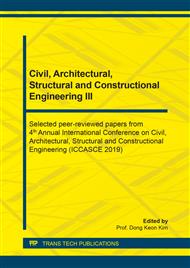p.142
p.147
p.152
p.157
p.166
p.173
p.179
p.185
p.190
Investment of Steel Reinforcement Extracted from Destroyed Buildings in Iraq
Abstract:
The number of destroyed cities in Iraq has increased significantly over the last five years. It presents a negative impact on the country's economy on the one hand and on the environment on the other. Reconstruction of these cities requires substantial capital to provide building materials needed for reconstruction and this leads to depletion of natural resources. This paper aims at finding an effective management method that contributes to the investment of the remnants of the components of destroyed buildings, including reinforcing steel, using the building information modelling (BIM) technique. The results showed that the amount of steel reinforcement that can be obtained from the destroyed buildings is enormous. Therefore, these quantities must be addressed through reusing or recycling. The sale of these quantities as recycling materials can provide a large income which can be added to the capital of the project.
Info:
Periodical:
Pages:
166-172
Citation:
Online since:
April 2020
Authors:
Keywords:
Price:
Сopyright:
© 2020 Trans Tech Publications Ltd. All Rights Reserved
Share:
Citation:


